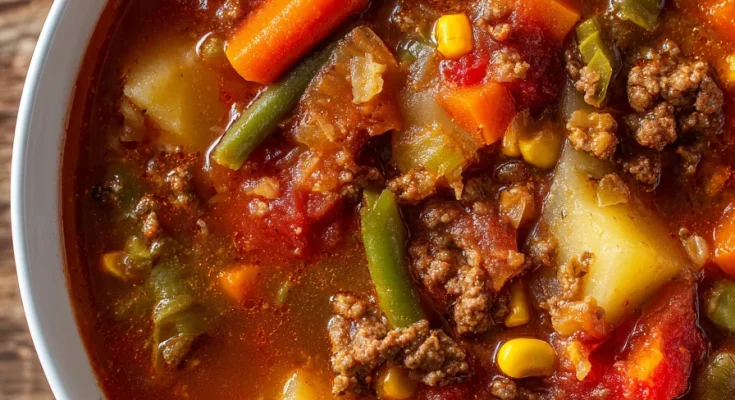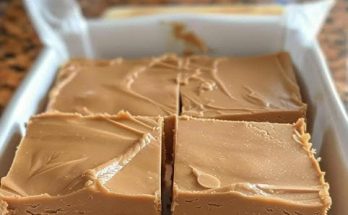
There’s something magical about a pot of homemade vegetable beef soup simmering on the stove. The aroma fills the kitchen, instantly bringing back cozy memories of family dinners, chilly evenings, and bowls of hearty comfort food served with warm bread. For me, this soup has always been more than just a recipe—it’s the kind of dish that makes everyone slow down, gather at the table, and savor spoonfuls of nourishing goodness.

Growing up, my grandmother made a version of vegetable beef soup almost every Sunday during the fall and winter months. She always said it was her “end-of-the-week clean-out-the-fridge soup,” tossing in leftover vegetables and scraps of beef to create a meal that tasted like it had been planned all along. I remember watching her stir the pot, sneaking little bites of tender beef or sweet carrots while she wasn’t looking. It was one of those recipes that never had exact measurements but somehow always came out perfect.
Fast forward to today, and this soup is still one of my go-to comfort meals. The beauty of it is how flexible it is—you can use fresh garden vegetables in the summer, rely on frozen when you’re short on time, or even stir in pantry staples like canned tomatoes and beans. Every variation is delicious, but the foundation remains the same: rich beef, tender veggies, and a savory broth that warms you from the inside out.
If you’ve never made vegetable beef soup from scratch, don’t worry—it’s easier than it looks. With a few smart tips and a little patience, you’ll have a hearty, nutrient-packed dinner that tastes better than anything from a can. Plus, it makes a big batch, which means plenty of leftovers for lunch the next day (and trust me, the flavors only get better as it sits).

Why You’ll Love It
-
Hearty and Filling: Packed with tender beef, potatoes, and a rainbow of vegetables, this soup is a complete meal in one bowl.
-
Nutritious: Loaded with fiber, protein, and vitamins, it’s a nourishing choice the whole family can feel good about.
-
Customizable: Swap in your favorite veggies, add pasta or rice, or even make it low-carb—it’s a recipe that adapts to your needs.
-
Meal Prep Friendly: Freezes beautifully and reheats well, making it perfect for busy weeknights.
-
Classic Comfort Food: It’s the kind of recipe that feels like a hug in a bowl, especially on cold, rainy days.
Ingredient Notes & Details
-
Beef Stew Meat: Look for chuck roast or pre-cut stew beef. Browning it first adds depth of flavor. If you want to stretch your budget, use ground beef instead.
-
Potatoes: Russet or Yukon gold are best because they hold their shape in soup. Dice them into bite-sized pieces for even cooking.
-
Carrots & Celery: Classic soup vegetables that add sweetness and earthiness. Slice evenly so they cook at the same rate.
-
Onion & Garlic: The base of flavor—don’t skip them. A yellow onion works best for balance.
-
Tomatoes: Canned diced tomatoes or crushed tomatoes create a rich, tangy broth. Fire-roasted adds extra smokiness.
-
Beef Broth: Go for low-sodium so you can control the salt. Homemade broth makes it even more flavorful if you have it on hand.
-
Green Beans, Corn, and Peas: Frozen or fresh both work. Add them toward the end of cooking so they don’t get mushy.
-
Seasonings: A mix of bay leaves, thyme, parsley, salt, and pepper is classic. You can also add Italian seasoning for extra flavor.
Pro Tip: Always taste the broth before serving—vegetables can absorb a lot of seasoning, so you may need to adjust with a little extra salt, pepper, or even a splash of Worcestershire sauce.

Step-by-Step Instructions
-
Brown the Beef
Heat a large soup pot or Dutch oven over medium-high heat. Add a drizzle of olive oil, then sear the beef chunks until browned on all sides. This step locks in flavor and creates those caramelized bits at the bottom of the pot (don’t skip it!). Remove the beef and set aside. -
Sauté the Aromatics
In the same pot, add chopped onion, carrots, and celery. Cook until softened, about 5 minutes, then stir in garlic for another 30 seconds until fragrant. -
Deglaze the Pot
Pour in a splash of beef broth or a bit of red wine, scraping up all the browned bits from the bottom of the pot. This adds incredible depth of flavor to the soup base. -
Build the Broth
Add the beef back in along with the rest of the broth, diced tomatoes, potatoes, bay leaves, and thyme. Stir well, bring to a boil, then reduce to a simmer. Cover and cook for about 1 to 1 ½ hours, until the beef is fork-tender. -
Add the Veggies
Stir in green beans, corn, and peas. Continue simmering for another 15–20 minutes until vegetables are tender but not overcooked. -
Taste and Adjust
Remove the bay leaves, taste the broth, and adjust seasonings as needed. A dash of Worcestershire sauce or a squeeze of lemon juice can brighten the flavor right before serving. -
Serve and Enjoy
Ladle the soup into bowls and garnish with fresh parsley. Serve with crusty bread or biscuits for a complete meal.

FAQ
Can I make vegetable beef soup in a slow cooker?
Yes! Brown the beef and sauté onions first for best flavor, then transfer everything to a slow cooker. Cook on low for 7–8 hours or high for 4–5 hours.
Can I use ground beef instead of stew meat?
Absolutely. Brown the ground beef, drain excess fat, and proceed with the recipe. It’s quicker and still delicious.
How do I thicken the broth?
For a thicker soup, mash a few of the potatoes right in the pot or stir in a cornstarch slurry (1 tablespoon cornstarch mixed with 2 tablespoons cold water).
Can I freeze vegetable beef soup?
Yes! Let the soup cool completely, then freeze in airtight containers for up to 3 months. Thaw in the fridge overnight before reheating.
What’s the best way to reheat it?
Warm gently on the stovetop over medium heat, adding a splash of broth or water if it’s too thick. Microwaving works too, but stir halfway for even heating.
Can I make it gluten-free?
Yes—just double-check your broth and seasonings. Everything else is naturally gluten-free.
Storage Tips
-
Refrigerator: Store leftovers in an airtight container for up to 4 days.
-
Freezer: Freeze in single-serve portions for easy meals later. Be sure to leave a little room at the top of the container for expansion.
-
Reheating: Always reheat gently so the vegetables don’t get mushy.
Variations
-
Low-Carb Version: Skip the potatoes and add zucchini, cauliflower, or extra green beans.
-
Add Pasta or Rice: Stir in cooked pasta or rice during the last 10 minutes of cooking for an even heartier version.
-
Spicy Kick: Add red pepper flakes, chili powder, or a diced jalapeño for heat.
-
Herb Twist: Try fresh rosemary or basil instead of thyme for a different flavor profile.
-
Protein Swap: Use shredded chicken or turkey instead of beef for a lighter twist.


Vegetable Beef Soup
Ingredients
- 1 lb 450 g beef stew meat, cut into bite-sized cubes
- 2 tbsp olive oil or vegetable oil
- 1 medium onion diced
- 3 cloves garlic minced
- 3 medium carrots sliced
- 3 celery stalks sliced
- 3 medium potatoes peeled and diced
- 1 cup green beans trimmed and cut into 1-inch pieces
- 1 cup corn kernels fresh, frozen, or canned
- 1 cup peas fresh or frozen
- 1 can 14.5 oz / 400 g diced tomatoes with juice
- 8 cups beef broth or enough to cover
- 2 tsp salt to taste
- 1 tsp black pepper
- 1 tsp dried thyme
- 1 tsp dried parsley
- 2 bay leaves
Instructions
-
Brown the Beef
-
In a large soup pot or Dutch oven, heat oil over medium-high heat.
-
Add beef cubes, season lightly with salt and pepper, and brown on all sides (about 5–6 minutes).
-
Sauté Vegetables
-
Add onion and garlic, cooking until softened and fragrant (about 2 minutes).
-
Simmer the Base
-
Pour in beef broth and diced tomatoes.
-
Stir in thyme, parsley, and bay leaves.
-
Bring to a boil, then reduce heat to low and let simmer for 30 minutes, partially covered.
-
Add Root Vegetables
-
Stir in carrots, celery, and potatoes.
-
Simmer another 20 minutes, until potatoes begin to soften.
-
Add Remaining Vegetables
-
Mix in green beans, corn, and peas.
-
Simmer for 10–15 minutes, until all vegetables are tender and beef is cooked through.
-
Taste and Adjust
-
Remove bay leaves.
-
Taste and adjust seasoning with additional salt or pepper.





